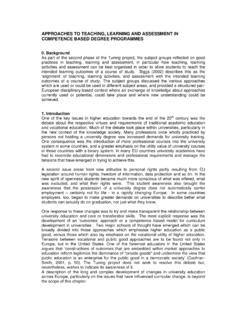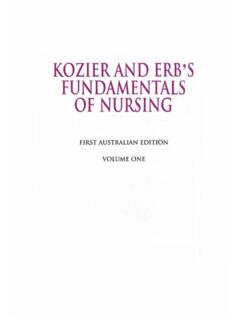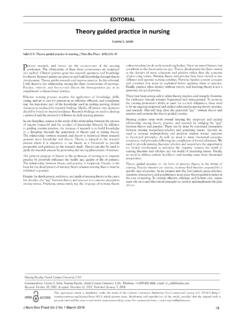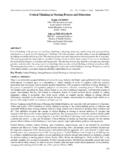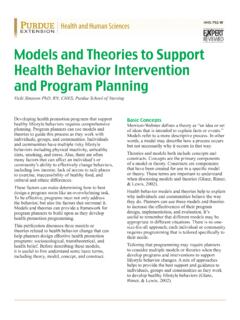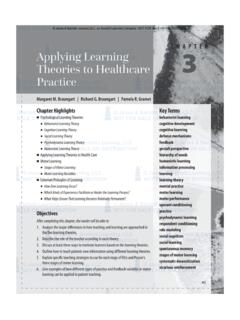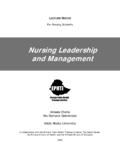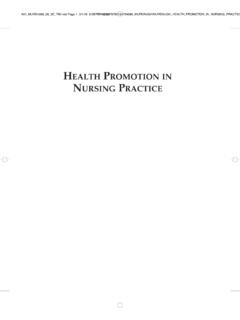Transcription of APPROACHES TO TEACHING, LEARNING AND …
1 APPROACHES TO teaching , LEARNING AND ASSESSMENT AND THE SUBJECT AREA COMPETENCES nursing Good teaching means that Faculty, as scholars, are also learners Boyer 1990:23-4 There is a well established knowledge and evidence base associated with the LEARNING , teaching and assessment of nursing and nurses: some illustrative texts are outlined at the end of this paper. Boyer s scholarship typology can be aptly applied to nursing in so far as he considers four types of scholarship: that of discovery/research, integration, application/service and that of teaching itself. Nurse learners, whether before or after qualification, are by definition adult learners undertaking an academic, professional/vocational programme of studies that includes both theoretical and practical knowledge, behaviours and attitudes and the ability to perform in routine and unpredictable situations.
2 The pedagogical knowledge base includes concepts and research associated with andragogy, experiential LEARNING , work based LEARNING , organisational cultures and LEARNING , decision making, development of leadership skills, social psychology of LEARNING , values, ethical and emotional literacy to name but a few. The different APPROACHES to LEARNING have all been included in the history of curriculum design and implementation, for example cognitive, behavioural, constructivist and post modern APPROACHES to nursing and nurse education. theories of competence acquisition, clinical decision making, mentorship, expert practice (Benner), tacit knowledge (Polanyi) and reflection (Schon, Johns, Gibbs) are well established. theories or models that have been applied to nursing include Bloom s cognitive taxonomy of LEARNING , Steinaker and Bell s experiential taxonomy; Dreyfus and Dreyfus and Benner s work on novice to expert development.
3 There is an increasing emphasis on collaborative LEARNING styles, especially at second cycle level. With at least fifty per cent of the registration programme being practice based, understanding and applying the evidence based of how students learn and develop in practice is crucial. A typical developmental model is that of Benner outlined in Box 1. Box 1 Benner 1984. Novice to a developmental model Benner conducted research using the Dreyfus Model (1981) which posits that the acquisition and development of a skill a student passes through 5 levels of proficiency novice advanced beginner competent proficient, expert These stages reflect changes in 3 general aspects of skill performance (1) Movement from the reliance on abstract principles to the use of past concrete experience as paradigms. (2) from LEARNING pieces to a complex whole with the ability to focus on relevant components at a time (3) from detached observer to attached performer Example using Blooms cognitive taxonomy: applied to the theoretical comprehension of medications Level 6: Valuing Draw conclusions, defend, and make decisions Realizes patient is in pain, reviews medication chart and following patient assessment and dialogue, chooses appropriate medication from prescription list.
4 Suggests change in therapy following evaluation of effectiveness. Level 5: Synthesis Draw conclusions, find connections, derive, make comparisons Patient complains of dizziness, especially on getting out of bed. Reviews patient and realizes that two medications may be interacting to the patient s detriment. Level 4: Analysis Find parts in a whole and connections, discern, criticize, and make comparisons. Reviews a patient s health status and medication regime and can explain the rationale behind the medication therapy for this particular patient. Level 3: Application Demonstrate, explain, make use of knowledge Knowledge of action of steroids enables student to explain to patient the importance of glucose monitoring while on these drugs. Level 2: Understanding Formulate knowledge in own words, explain, account for, show differences Able to recognize the difference between diuretics that are potassium sparing and those that are not. Level 1: Basic knowledge Define, declare, count, recognize Can identify normal therapeutic range of common drugs.
5 The concept of differentiation is crucial to nursing to enable development, progression and achievement of safe, intelligent practice in the real world of patients and their families/loved ones. This is why we argue for a sub first cycle level descriptors en route to the first cycle achievement of competence. Many typologies of LEARNING do not accord value to the role of apprenticeship, craft knowledge and skill acquisition that are often fundamental to LEARNING in a person based practice. Models of LEARNING and teaching Through analysis of nursing in our representative 13 countries, we considered that while there is a place for many different models of LEARNING and teaching in nurse education, the models are used in different proportions according to the resources available and the developmental stage of the learner ( Figure 1). Typically there are the (1) traditional methods of instruction (2) behavioural and instructional models (3) constructivist models and (4) collaborative APPROACHES to LEARNING .
6 However, as previously indicated, there is often insufficient attention to experiential LEARNING , LEARNING in the workplace and the established and extensive research base in this field. The traditional model or apprenticeship model still has an important place in LEARNING nursing for novices or at the novice stage of a more complex competence acquisition. These methods are relevant to the development of safe practice, for examples LEARNING lifting and handling of patients and the safe and precise acquisition of procedures. Craft knowledge is often passed on traditionally and it is appropriate to do so in workplaces where role modelling and coaching develop practises ahead of the evidence base: this applies to both novices and experts. Many first cycle programmes have increased their emphasis upon collaborative LEARNING APPROACHES as evidenced by enquiry based and action LEARNING styles.
7 Behavioural, instructional and constructivist models are often used for teaching skills. In contrast, second cycle programmes tend to focus more upon constructivist and collaborative models of LEARNING . Figure 1. A theoretical conceptualisation of how the four models may be balanced within first and second cycle curricula. Cycle Model I. II. 1. traditional 2. behavioural/instructional When human and material resources become available, there is a rise in small group work and technology assisted teaching / LEARNING . During recent years there has been an increasing use of reflective, critical APPROACHES to LEARNING matched by the use of informatics to support web based and work place LEARNING . Practical skills are often developed through observation of practice, demonstrations, simulations, role play and exposure and engagement in real clinical experiences.
8 However, many countries reported the challenges encountered during work placed LEARNING placements when there may be problems with student supervision and the quality of patient care. To this end, where available, resources are now being allocated to support learners in practice, to prepare students for practice through clinically based wards, clinical skills laboratories and through the use of simulations or virtual practice. Critical enquiry has been fostered by enquiry, problem, scenario and action based LEARNING . Role play and other experiential modes are adopted in a variety of forms to develop communication skills, team building and to sensitise students to the experience of patients and clients ( blind walk, being fed on one s back); to enable rehearsal of skills and emotions (breaking bad news); decision making and prioritisation (games, simulations). Interprofessional LEARNING is now more common and is developing its own evidence base (Barr 1998).
9 Training Needs Analysis combined with workforce review and skill mix analysis are often used to identify education and training needs, particularly in post qualifying education. Here is a typical model. TRAINING NEEDS ANALYSIS (adapted from Spilsbury M 1995 Measuring the Effectiveness of Training, IES, Brighton; Figure p12) Identification of training needDesign, preparation and delivery of training Reaction to, & LEARNING from the trainingTransferring training to the workplace Evaluating the impact on the organisationMeasuring positive effects teaching terms/methods See reference list for definitions Typical use by Tuning Departments in nursing : Frequently/Sometimes/Rarely Definition or meaning if used in your country for nursing (or give reference to a defined text commonly used- see Annex 3) B D F G H I M Ne No Sk Sp UK Lectures F FFSFFFF F F F F Teacher led session largely informative Tutorials S FFFSFSS S F F F Teacher facilitated topic based interactive session for one or more students Small group F FFFFFSS F F F F Large group teaching S S R F F FF F F F F Varies upon course and no of students Practicals F * * F F SS F F F Rehearsing practical skills in a non clinical environment Practice in clinical areas F FS* FSFF F F F F nursing experience Laboratory work F S * * F F * * F S F Using scientific laboratories for experiments or investigations Reading
10 S FFFFFFF F F F F Guided study f FFFFFFF F F F F Prepared work for students on given topics Workbook F F S R F S FF S F F S Structured theoretical tasks that are recorded in written format Discussion F FFFFFSS F F F F Oral exchange of ideas Debates S FFFFSSS F F S S Contesting and defending ideas Role play F S R S F F SS S S F S Acting a part Simulation F RRRF RSS S S F F Practising situations that are not real Observational visits S R S R F R SS S S S Visits to.
